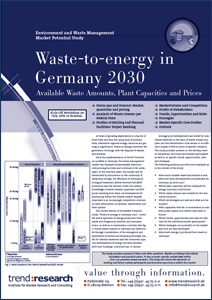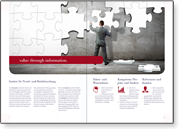Waste-to-energy in Germany 2030 (Geplant)
Available Waste Amounts, Plant Capacities and Prices
Broschüre:

At times of growing dependency on imports of fossil fuels and thus the rising price of primary fuels, alternative regional energy resources are gaining in significance. Waste-to-energy combines the generation of energy with the disposal of wastes and residues.
Since the implementation of the EU Directive on Landfills in Germany, the waste management market has changed fundamentally. Extensive restructuring has been and continues to be undertaken. In the next few years, the market will be determined by discussions on the continuity of temporary storage, the efficiency of mechanicalbiological treatment, Refuse Derived Fuel (RDF) production and the German Green-Dot system.
Knowledge of waste streams, quantities and RDF prices resulting from them are fundamental for positioning within the volatile market. Equally important is an increasingly competitive orientation with information on facilities, stakeholders and their options.
The current edition of the Market Potential Study, “Waste-to-energy in Germany 2030”, covers the entire spectrum of energy production from waste and (biogenous) residues, and examines mono- as well as co-incineration activities. Future waste streams in Germany are determined through consideration of the emergence and availability of wastes and residues potentially usable for thermal treatment and the connected capacity developments of energy recovery facilities with new buildings, continued use, or closure.
Average price developments are stated for individual materials on the basis of waste stream analyses and the identification of an excess or in-sufficient supply of RDF in terms of specific scenarios. The study provides answers on the develop-ment of competition structures and market participants as well as on specific trends, opportunities, risks and strategies.
The following questions provide some examples as to the content of the study:
- How much suitable waste and residue is available and what developments are predicted for Germany up until 2030?
- Which plant capacities will be employed for energy recovery in the future?
- Which waste streams are suitable for the individual fractions?
- Which technologies are used and what are the reasons?
- What capacities will the co-incineration in coalfired power plants and cement kilns have in future?
- Which trends, opportunities and risks are relevant for the individual market participants?
- Which strategies are successful on the market and how are they developed?
- How much energy is produced from waste in Germany?
On the basis of the current developments and discussions within Germany, the study demonstrates and analyses the future development of the Waste-to-Energy market up until 2030 in terms of different scenarios. Alongside the quantitative analysis of the market, (e.g. quantities and price developments), the market will be portrayed via a qualitative depiction (e.g., competitor intensity, opportunities and risks, etc.). Based on these data and forecasts, the study enables its readers to assess the plausibility of their own strategies and market data. Furthermore, the analysis of trends, opportunities and risks within the market contributes towards optimum market positioning in decisions pertaining to strategy and investment.
trend:research implements a variety of field and desk research methods. Alongside extensive intranet and internet database analyses (including journals, publications, conferences, company reports, etc.), the market potential study comprises approximately 100 structured interviews with the following target groups:
- Operators of Municipal Solid Waste (MSW) plants (for mainly low-calorific waste)
- Operators of Refuse Derived Fuel (RDF) plants (for mainly middle-calorific waste)
- Operators of mono-incineration plants
- Operators of coal and lignite-fired power plants
- Operators of cement works
- Producers of RDF
- Operators of biomass plants
- Transport companies (waste, RDF)
- Other service providers and consultants
The analysis of field and desk research data leads to reliable conclusions regarding markets, trends, competition and dealing with the options within the Waste-to Energy market. By means of the multivariate Trend-Impact-AnalysisTM, data and information are quantified and structured into a knowledge database. This is then used to build scenarios and deduce accurate market predictions.
The market potential study is aimed at all stakeholders within the market of energy production from wastes and residues, thus providing a fundamental view of all data, discussions and market movements relevant to this market. By means of detailed analyses of waste streams, pricing and the market itself, the study offers an overview for stakeholders in the waste management industry, operators of power plants and energy facilities and investors. The study is also aimed at facility constructors and planners, as well as further service providers from the waste management industry.
The study is of particular use and relevance to committee chairs, management boards, industrial strategy developers, marketing and sales representatives.
